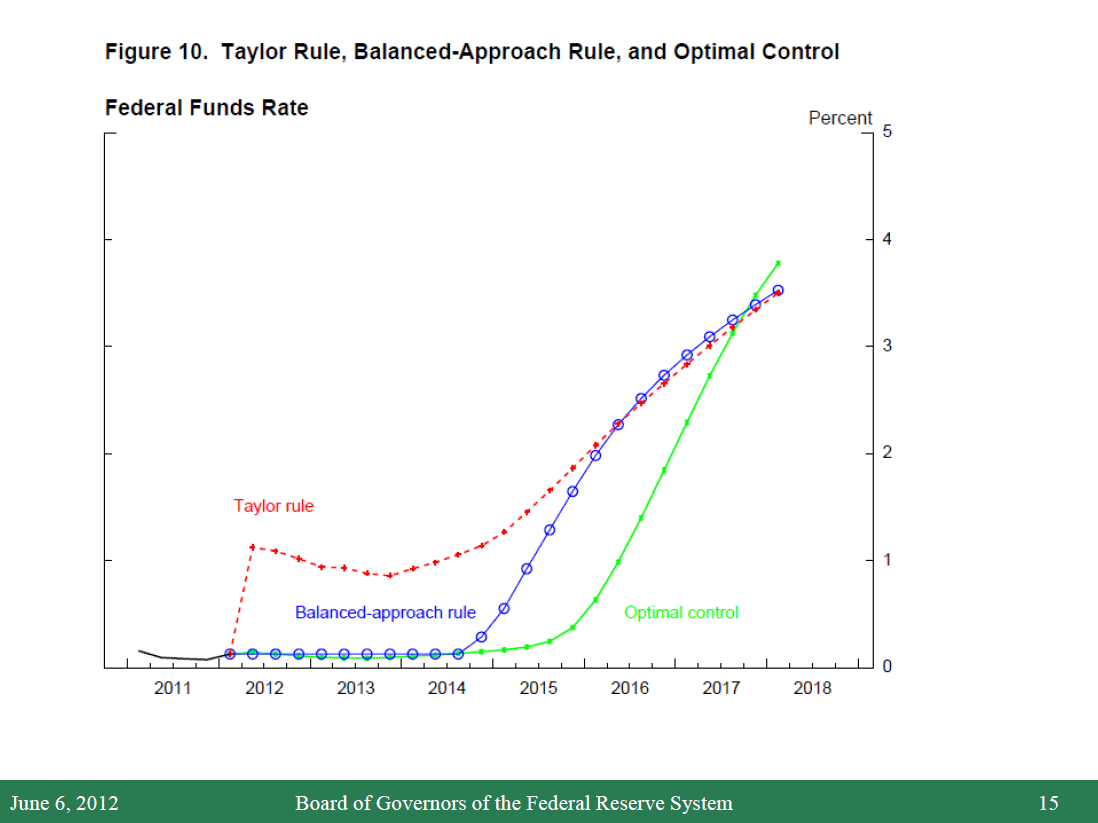Here's why advocating NGDP targeting is just plain silly
Matthew Martin
3/10/2014 02:22:00 PM
Tweetable

I won't comment on how other central banks work, or whether other countries should adopt an NGDP target, but for the US I think this discussion is all pretty silly.
In the Macroeconomics research literature, it is customary to model the Fed as following what's called a "Taylor Rule," which is a rule that prescribes a particular interest rate target depending on certain objective, measurable inputs such as the unemployment rate and inflation. Many economists have estimated different versions of the Taylor Rule, but the best-estimated version I've seen, by far, is from Glen Rudebusch, a research economist at the Fed who estimated that this rule is the best fit for the Fed's choice behavior, out all possible Taylor-type rules:
r = π + 0.28 ( π − π * ) + 1.95 ( u * − u ) + 1.61
Now here's that in a graph:


"Today, I will consider the prescriptions of two such benchmark rules--Taylor's 1993 rule, and a variant that is twice as responsive to economic slack. In my view, this latter rule is more consistent with the FOMC's commitment to follow a balanced approach to promoting our dual mandate, and so I will refer to it as the "balanced-approach" rule."One explanation why the fed has failed to follow any consistent policy rule is because the Fed was incapable, for one reason or another, of doing so.
It could be that monetary policy simply isn't as potent as economists think, and the Fed's limited arsenal of policy instruments have little control over any of these time series. But I think Yellen's odd recommendation is very telling. She derived both an optimal control rule and a taylor rule, and then advocated a compromise path between the two. This tells me that Arrow's Theorem is dictating the Fed's behavior: Yellen could have chosen a loss function that would produce an optimal control path that corresponds to her actual policy recommendations--the choice of loss function was arbitrary and subjective. Instead she picked one that was more extreme than what she wanted as a way of changing the elements in the choice set before the FOMC. The preferences of the members of the FOMC are highly heterogeneous, meaning that, per Arrow's Theorem, by changing the set of possible choices Yellen also changed the median voter on the FOMC, and therefore changed the preferences of the FOMC as a whole.
To put it bluntly, Arrow's Theorem says that the FOMC is incapable of making rational, time-consistent choices, because it's preferences change depending on how the various choices are posed to the committee. This precludes any possibility of the FOMC committing to any monetary policy rule for long periods of time.
The preferences of the FOMC are quite heterogeneous. Of the current 10 voting FOMC members, only four were academic economists, and two others have previously held positions with the title "economist"--that means 4 members, nearly half the committee, are not economists (three lawyers and one banker). What economists think about monetary policy rules is less relevant to the FOMC than you might think, and there is quite a bit more disagreement within the FOMC than you might have suspected. This in itself is enough for Arrow's Theorem to bite, but we have to add in the fact that at the FOMC, the median voter literally gets changed out every year as membership rotates between different regional bank presidents on an annual basis. The Fed was designed in a way to guarantee it would be incapable of following a consistent policy rule.
So, in my view, debating which version of NGDP targeting would be optimal is a lot like the lazy fat guy looking for advice on how to improve his mile time. To have a mile time at all, he first needs to be able to run a mile! Similarly, for the Fed to adopt an NGDP target, it first needs to be able to commit to a policy rule. At present, that isn't possible.
This sounds like an extreme form of American exceptionalism. OK, the US is different, and the Fed is set up differently from the Bank of Canada (it's a republic vs a monarchy), but the US is not some anarchic total mess of a country. You have the rule of law, and even a constitution. What are those things except a decision to keep Arrow under control?
The more people who see 5% NGDP as a Schelling focal point that frames the conversation, the closer it will be followed, even in anarchy. That's why society exists at all.
Also, I don't doubt that, by altering the choice set, discussion of NGDP targeting can alter the Bank's behaviors--Arrow's Theorem says it will. My point is that we won't actually end up with an NGDP target because the committee's preferences will change as soon as any of the facts change.